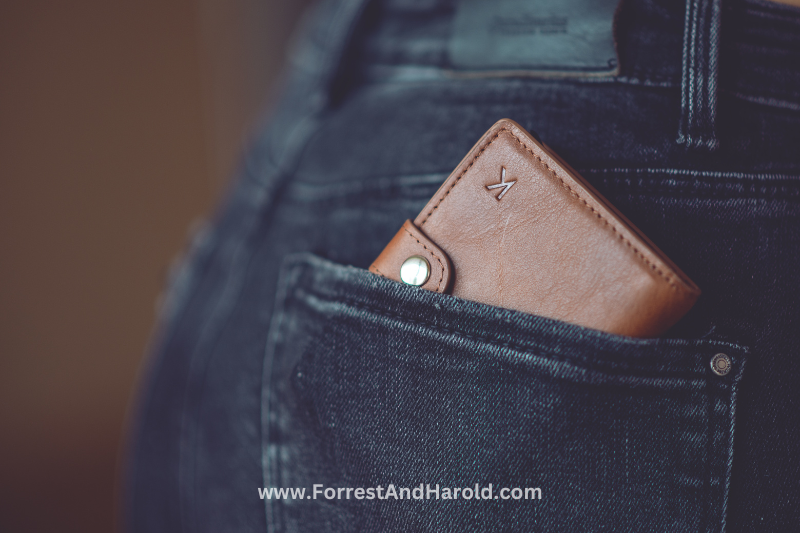As you set out to locate the ideal wallet, our Wallet Buying Guide is here to help in making a well-thought-out selection. Selecting the ideal wallet can be a challenging process, given all the factors to consider like material options, size and capacity, style preferences and more.

This guide will provide a detailed analysis of wallets across different price ranges. We'll cover budget-friendly options that cost less than $30 and high-end choices that exceed $100. Furthermore, we'll discuss the significance of RFID blocking technology in safeguarding personal information.
When it comes to choosing a men's wallet, there is an ongoing debate between minimalist and traditional designs. In this guide, we will examine the benefits of each type and highlight their unique characteristics. It is important to prioritize quality and durability when selecting a wallet, which is why our guide emphasizes the importance of material selection and brand reputation.
Last but not least, customization options such as monogramming or unique design choices add a personal touch to your new accessory. By following our Wallet Buying Guide closely, you're sure to find the ideal wallet that meets all your requirements with ease.
Table of Contents:
- Factors to Consider When Buying a Wallet
- Price Range of Wallets
- RFID Blocking Technology Benefits
- Minimalist vs Traditional Wallet Designs
- Investing in Quality and Durability
- Customization Options
- FAQs in Relation to Wallet Buying Guide
- Conclusion
Factors to Consider When Buying a Wallet
When buying a wallet, you need to think about the material, size, style, and additional features to make the best choice for your needs.
Material Matters
The material used in constructing a wallet plays an important role in its durability and appearance. Leather is timeless and durable, while fabric wallets offer more casual alternatives.
Size and Capacity
To determine the right wallet size, consider your daily carrying needs. If you only need to carry essential cards and cash, a slim wallet is ideal. However, if you require more organization, opt for a larger wallet with multiple compartments.
Style Options
- Bifold: A classic option with ample storage space.
- Trifold: Similar to bifold but with more storage options.
- Slim/Cardholder: A minimalist design for essential cards and cash.
When selecting a wallet, take into account these elements to ensure that you acquire one which is stylish and can provide long-term service.
Price Range of Wallets
Wallet prices vary depending on brand, materials, and design, so set a budget before buying; we suggest $55-$75 for a high-quality wallet.
Budget-friendly wallets under $30
Don't want to break the bank? Check out these affordable wallets under $30 made from synthetic materials or lower-grade leather.
- Himawari Women's Vegan Leather Long Wallet
- Travelambo Front Pocket Minimalist Leather Slim Wallet
- Buffway Slim Minimalist Front Pocket RFID Blocking Leather Wallets
Mid-range wallets from $30-$100
Investing a bit more money in a mid-range wallet can pay off with increased durability and better protection for your cards and cash.
- Bellroy: Popular for their slim designs and quality materials.
- Fossil: Offers a wide range of styles and materials.
- Forrest & Harold: Our very own collection of stylish and functional wallets.
Luxury wallets over $100
- Maison Margiela: Known for avant-garde designs that make a statement.
- Gucci: A high-fashion staple with stylish and durable leather wallets.
- Tumi: Offers premium materials and excellent organization features.
Remember to consider material quality and brand reputation before making your final decision on how much to spend on a new wallet.
RFID Blocking Technology Benefits
Concerned about identity theft and credit card fraud? Consider investing in an RFID blocking wallet.
These wallets are lined with military-grade RFID blocking material, preventing unauthorized scanning devices from accessing sensitive information stored within cards.
How does RFID technology work?
RFID technology uses electromagnetic fields to transfer data between a tag embedded in your card and a reader device, enabling contactless payments.
However, thieves can use portable scanners to steal your card information without physically touching it.
The importance of protecting personal data
- Data breaches: Unauthorized access to your financial information can lead to fraudulent charges or even identity theft.
- Credit score impact: Identity theft can result in false negative marks on your credit report, affecting loan approvals and interest rates.
- Potential loss of funds: Stolen card details can lead to drained bank accounts.
Many people choose wallets with built-in RFID protection to combat these risks.
By shielding cards from unwanted scans, these wallets keep personal data secure while still allowing for the convenience of contactless payments.
When shopping for an RFID blocking wallet, consider factors such as material, design, and quality to ensure it meets your needs.
Minimalist vs Traditional Wallet Designs

Choosing between minimalist or traditional wallet designs depends on personal preference and lifestyle requirements.
- Slim profile: Minimalist wallets are slim and compact, making them easy to carry in your front pocket.
- Fewer items: Limited space forces you to prioritize which cards and cash you need, simplifying your life.
- Quick access: Many minimalist wallets have quick-access slots for frequently used cards, allowing for faster transactions.
- Larger capacity: Bi-fold and tri-fold wallets offer more room for storing cash, cards, receipts, and other essentials.
- Coin compartment: Traditional-style wallets often include a zippered coin pouch for storing small items like keys or SD cards safely.
- Photo ID window: Traditional wallets often feature a clear ID window for easy access to identification.
- Bill divider: Some wallets come with a bill divider to help you separate different denominations of cash or keep receipts organized.
Ultimately, evaluate what features are most important for your daily routine before making a decision.
Investing in Quality and Durability
When choosing how much to spend on a wallet, bear in mind the quality and resilience of the item - investing in one that is crafted from top-notch materials will last longer and provide more reliable protection for your cards and money, ultimately saving you cash over time.
Importance of Material Selection
The material used in constructing a wallet plays a significant role in its overall quality and durability - full-grain leather is among the highest grade available, while synthetic materials like nylon or polyester may be more budget-friendly but typically lack the same level of durability as leather.
Brand Reputation for Quality Products
Research various brands' reputations for producing high-quality products that stand up over time - popular men's accessory brands known for their craftsmanship include Bellroy, Herschel Supply Co., and Forrest & Harold.
- Action Step: Research different wallet materials and their respective durability levels to make an informed decision on which material best suits your needs.
- Action Step: Browse various wallet brands, read customer reviews, and compare products to find a brand that consistently delivers quality items worth investing in.
Customization Options
Personalize your wallet with monograms, engravings, or unique designs to reflect your individual style and potentially increase satisfaction levels.
Monogramming options
Add your initials to your wallet for a personal touch and easy identification if misplaced; choose from block letters, script fonts, or intricate designs.
Unique design choices
- Engraving: Engrave a special message or symbol on your wallet to make it one-of-a-kind; some brands offer engraving services directly or through third-party vendors like Things Remembered.
- Limited edition wallets: Look for exclusive colors, patterns, or artwork from popular brands for unique conversation starters that showcase your personality.
- Ethical materials: Choose wallets made from vegan leather or recycled fabrics to make a statement about your values and contribute to a more eco-friendly lifestyle.
Remember, customization can elevate your wallet's look and feel while reflecting your personal style, but be mindful of any additional costs associated with these options.
FAQs in Relation to Wallet Buying Guide

How to Choose a Good Wallet
Consider material, size, style, and budget when selecting a wallet; look for quality materials like leather or fabric, RFID blocking technology for security, and reputable brands known for durability.
Why You Need a Wallet
A wallet keeps your cash, cards, and identification organized and secure while reflecting your personal style; investing in a high-quality wallet ensures longevity and better protection of your belongings.
How Much to Spend on a Wallet
Wallet prices vary based on quality: budget-friendly wallets under $30, mid-range wallets from $30-$100, and luxury wallets over $100; choose based on your budget without compromising quality or functionality.
Billfold vs. Wallet
A billfold is smaller with limited compartments for bills and sometimes cards, while wallets have multiple compartments for cash, cards, ID, and documents, providing more storage space overall but potentially bulkier designs.
For more information on choosing the perfect wallet, check out Money Crashers.
Conclusion
Wallet Buying Guide: Choosing the right wallet is crucial for your daily life, so consider factors like material, size, style, and price range to find the perfect fit.
For added security, look into wallets with RFID blocking technology, and decide between minimalist or traditional designs based on your personal preference.
Investing in quality materials from reputable brands ensures durability over time, and customization options like monogramming add a personal touch.
Don't forget to check out credible sources for reviews and recommendations before making your final decision.

